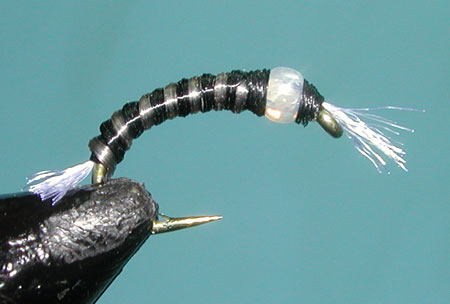Notes:
Chironomids are one of the most important food sources in stillwaters. They can represent 25-50% of the food source for trout, depending
upon season. There are three stages to consider, the larvae, pupa, and emergers. Colors range in frequency from Black, Brown, Red, Tan,
Green, and Cream. Many of the larvae will have a reddish appearance as they retain hemoglobin within the oxygen-poor depths. These larvae are often called bloodworms. The larvae are also quite larger than the pupa or emergers, sometimes up to two hook sizes. Generally, the largest chironomids will be during the Spring and will decrease in size through the Summer and Fall.
The earliest mention of a buzzer pattern was in England during the 1920's. Dr. H.A. Bell created a Blagdon Buzzer for fishing the Blagdon Reservoir. It was tied on a small hook and had a black wool body with a flat silver rib with a tuft of white wool behind the eye of the hook. It was very similar to the TDC pattern that Richard Thompson designed in the 1950's. Buzzer patterns fell out of favor until a resurgence of popularity in the 1960's when English reservoirs were opened to public fishing. C.F. Walker wrote about Buzzers in his book, Lake Flies and their Imitation, in 1960 and the use of Buzzer's for stillwater fishing became quite popular once more.
The Spanflex Buzzer became a popular pattern within England, New Zealand, Australia, and Canada with the introduction of a stretchy synthetic material, Spanflex. Spanflex is a very tough, stretchable material made by Wapsi in Arkansas and has a registered trademark with Wapsi. There are similar products such as Flex Floss and Midge Stretch Floss that can be substituted and some of these products are often referred to as "Spanflex". Spanflex is often used for legs, tails, and ribbing on larger flies. It makes great bodies on smaller midge flies. By applying somewhat little stretch to the material you can get a pronounced and broad segmentation. By applying considerable stretch, the segments will become quite small and flat. Two different colors of the Spanflex will add a mottled effect to the body. Also try spacing the Spanflex wraps over the thread body, this allows the thread color to show through and provides another mottling efect. The material is semi-translucent, so that the underbody of thread color will greatly affect the body coloration. For instance, the bloodworm Spanflex Buzzer uses a Ginger colored Spanflex which comes across quite red due to the red thread underbody. Also, note how the cream spanflex comes across as a mottled gray over the black thread body of the Black/Cream Spanflex larvae when it is stretched tight. A covering of an Acrylic such as Sally's Hard as Nails (Clear) will provide a tougher surface and protect the thread wraps around the bead. Loon's UV Fly Finish, Thin or Flow, will also provide an epoxy protection.
|


